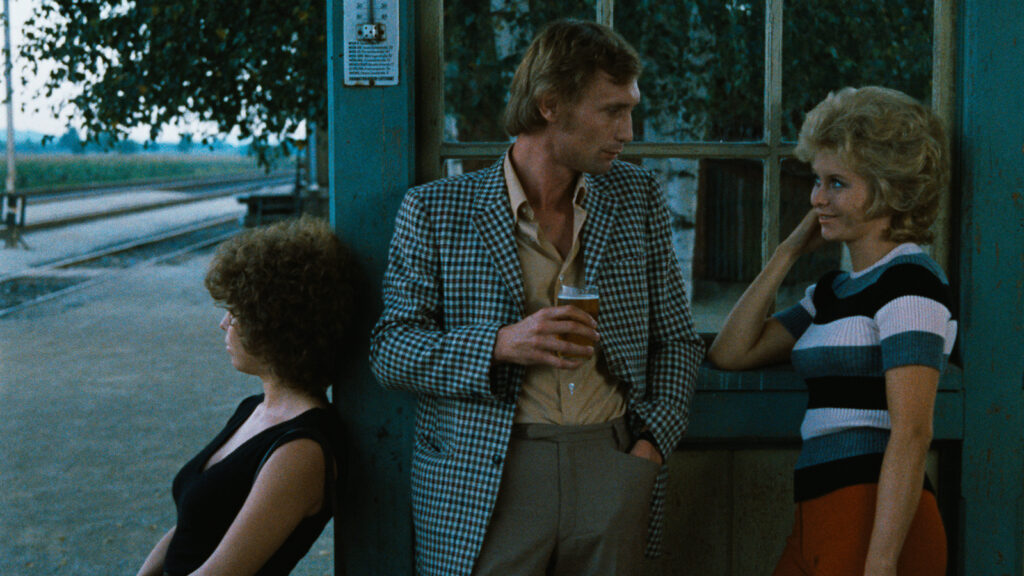
Peter Handke’s short novel Die Angst des Tormanns beim Elfmeter, published in 1970, is a neo-existentialist novel that serves as a meditation on lost identities. Sartre’s conception of the “signifier” and the “signified” is the basis for the internal crisis that dogs the novel’s protagonist Joseph Bloch after getting into a fight at a soccer game. Handke’s novel deals almost exclusively with Bloch’s interiority which doesn’t really lend itself aesthetically to a cinematic adaptation. However the basic premise of the narrative mirrors quite closely that of Wim Wender’s unofficial first feature film Summer In The City (1970) where Wenders determined the best way to communicate a character’s interiority is to let the shot linger or to cut to an insert shot where a suggestive object may allude to some subtextual element.
When Wenders was awarded the Kuratorium junger deutscher Film grant he set about adapting his friend Peter Handke’s novel. As he would do with Der Himmel über Berlin (1987), Peter Handke penned the dialogue in Wenders’ screenplay, taking care to avoid exposition at all costs. Handke, editor Peter Przygodda, and cinematographer Robby Müller all went on to become the core collaborative team for Wenders in the seventies and they all first worked together on Die Angst des Tormanns beim Elfmeter.
In terms of dramatic beats Die Angst des Tormanns beim Elfmeter is extremely minimal. First Bloch (Arthur Brauss) gets into a fight during the soccer game he’s playing and storms off, leaving his team’s goal unattended. Then he meets a ticket booth operator at a cinema whom he strangles after a night of lovemaking. From there Bloch slowly drifts to a rural border town casually awaiting the police. It takes Wenders’ only about half an hour to get to the third beat leaving roughly seventy minutes of the film to be dedicated to Bloch’s aimless drifting.
As stated above Bloch’s interiority is successfully translated from novel to film by Wenders’ use of lingering long takes and inserts. Each instance of either of these strategies is only so meanigful; it is the cumulative power of these images that give Bloch’s inner life real weight. The effect is an ever increasing sense of dread that seems to drift into the film from the most mundane places. Objects like an umbrella, a jacket, or a pack of Marlboros slowly gather to them a violent agency that echoes with the murder Bloch has committed. Der amerikanische Freund (1977) uses similar strategies though Wenders limits the subjects of these shots (inserts, long-takes) to the materials of Jonathan Zimmermann’s (Bruno Ganz) work as a framer.
Dealing more abstractly, the itinerate nature of Wenders’ protagonists, including Bloch, and Wenders’ own camera exist in a kind of loop. The camera makes an image of a character and what they see as the character themselves perceives an object as an image and asks “what?”. The camera, on the other hand, is far more inclusive in its gaze. The image that Wenders prints to celluloid isn’t an inquiry as to what a thing is, but rather why a thing is. As the film moves linearly along the narrative track so do the characters seeking these answers. The difference between the questions of the camera and the content is that those characters within often find an answer while those without who are totally reliant on a mechanism for our gaze often ponder “why” for much longer.
This proposition of duality is the crux of Die Angst des Tormanns beim Elfmeter. Handke’s novel looks to explore this relationship within the mechanics of the mind as if Bloch himself were a camera and all he sees is just some story in a film. Wenders transposes this connection from the psychological arena to the mechanical innards of a 35mm camera.
More than Wenders’ formal strategies Die Angst des Tormanns beim Elfmeter announced the filmmaker’s signature preoccupations to the world of cinema. It is true that Wenders’ proclivity for Rock n’ Roll soundtracks had been featured heavily in his student films and published essays. Die Angst des Tormanns beim Elfmeter doesn’t feature Wenders’ beloved popular American music as a narrative counterpoint or anything like that but rather as something totally commonplace and un-suggestive where the narrative is concerned. In addition to a penchant for Rock music Wenders’ films are obsessed with the permeation of American pop culture into West German society; at least up until Wenders joined Coppola in San Fransisco.
Wim Wenders was so proficient a filmmaker as a student that with Die Angst des Tormanns beim Elfmeter he emerges almost aesthetically matured. The thematic links and his style are all present and wholly effective in Die Angst des Tormanns beim Elfmeter, pointing the way for his famous Road Trilogy. Die Angst des Tormanns beim Elfmeter is a remarkably measured psychological thriller and an essential text in New German cinema.
